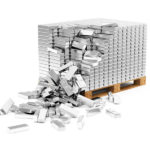Top money manager says gold may hit $1,500 for the first time since 2013
THANK YOU FOR POSTING A REVIEW!
Your review was sent successfully and is now waiting for our staff to publish it.
(June 27, 2017 - by Myra Saefon)
U.S. Global Investors’ Frank Holmes talks about gold’s outlook and a new ETF
Gold prices have climbed by around 8% year to date—close to what they gained for all of last year.
That comes as no surprise to Frank Holmes, chief executive and chief investment officer at U.S. Global Investors, and he sees lots of reasons why prices could rally further—potentially to as high as $1,500 an ounce. That would be a 20% rise from its current level of roughly $1,250.
“The metal is responding to the typical demand drivers that I always discuss, like geopolitical uncertainty, a weak dollar, low interest rates,” said Holmes. “Perhaps one of the most shocking things is that last week, for the first time since the November [U.S. presidential] election, gold was outperforming the U.S. dollar.”
Gold futures settled under $1,250 an ounce Monday, but they are up about 8% year to date. They haven’t traded above $1,500 in more than four years.
The weakening of the U.S. dollar DXY, -1.07% [as President Donald] Trump’s policy agenda continues to get derailed by all kinds of distractions” has been one of the biggest influences on the gold market, said Holmes.
Holmes said he believes the Fed is taking a more dovish approach to raising interest rates than expected. The Fed, however, is still penciling in another hike in 2017 and more in 2018, and plans to begin reducing the size of its balance sheet before the end of this year.
And “geopolitical risk and uncertainty, from Brexit to Trump’s policies to unrest in the Middle East,” he said, have given gold an added boost.
The “fear trade”—the idea that factors such as geopolitical turmoil, both here and abroad, and low-to-negative government bond yields drive the demand for safe-haven assets—is likely to continue to support gold, said Holmes.
“Right now, with rates still historically low and inflation in the 2% range, government bond yields are low to negative, in some cases,” he said. “Why would investors want to lock in negative yields for the next two to five years?”
“In light of this, I think haven investors see gold as a much more reliable store of value,” he said.
Physical demand for gold has reached record levels in both China and India, according to Holmes. The devaluation of the yuan and a slowing real-estate market has helped to drive demand in China, while India saw its gold imports rise fourfold in May from the same time a year, he said, as traders fear a higher tax rate on jewelry.
Meanwhile, central-bank purchases of gold are still “robust” in China and India, Holmes said.
“Currently gold only represents 2% of China’s foreign reserves. Compare that to the U.S. where gold represents 75%,” he said. That means “there is still an enormous opportunity for China to continue to accumulate the yellow metal.”
He said he’s “encouraged” by the gains that gold has seen in the first half of 2017, but “nobody can say what the future holds, so hope for the best but prepare for the worst.”
-
Silver Remains On The Defensive Below $27.50 On Easing Middle East Tensions By
Mint State Gold
April 24 2024






